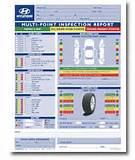The other day I took my car in to the dealer to get an oil change. What was cool was that I also got a free multi-point inspection of my car. They checked my tires, my oil, my brakes, all the various fluids, battery charge and so on. I noticed that my front brakes pads were in the “yellow” zone – getting to the point of wear. I didn’t need to replace them just yet, but I made a note on my calendar to have them replaced at my next oil change. I remembered an incident in the past where I didn’t do anything to my brakes until I started to hear some grinding. By then it was too late to replace the brake pads; I had to get a “brake job” which tripled my repair bill!
This made me think about other “multi-point inspections.” The doctor gives me an annual check-up. The dentist checks my teeth every 6 months. The eye doctor checks my eyes every two years. There are lots of multi-point inspections of my physical life.
How about our spiritual lives?
I think stagnation and “being stuck” are all-too-common symptoms among Christ-followers. And if I am not growing in Christ, it is my experience that I’m actually going backwards in my spiritual life. I am probably reverting back to habits of the flesh, becoming spiritually dull and complacent.
So how do we get a multi-point inspection of our spiritual lives? Where do we begin?
Over the years, I’ve been schooled in various ways to look at spiritual health and vitality. In my early college years, InterVarsity Christian Fellowship taught me to grow in Discipleship, Evangelism and Mission. Later on, I learned the Navigator “Wheel” (prayer, the Word, fellowship, witnessing). But I think the one of the best and well-rounded approaches to spiritual health is a paradigm that my home church developed. It’s called “The Six Spiritual Habits.” They are, in no particular order:
1. Biblical Growth
2. Authentic Community
3. Faithful Stewardship
4. Compassionate Outreach
5. Passionate Worship
6. Joyful Service
I like the six spiritual habits because they are balanced. For example, I believe stewardship and serving are two important practices that reveal the nature of our spirituality – but are highly neglected in many Christian circles. If they are not dealt with, our life quickly becomes imbalanced. The habits are also dynamic. Each habit is not just a discipline, but also a description of how they are to operate – for example, not just “worship,” but “Passionate worship.” For me, they serve as a good “multi-point inspection” of how I am progressing in my spiritual pilgrimage.
Over the next several days I’m going to focus on each of the six spiritual habits from a Whole Life Worship perspective. I hope you find the blogs helpful in how you look at and understand spiritual practices and their role in our transforming life in Christ.
Now the six spiritual habits are not meant to be an exhaustive list of all the spiritual disciplines. There are many good spiritual disciplines and practices that are not a part of the habits. Nor are they meant to be THE way to walk with Christ. It’s just a way to look at it. Every church and Christian organization usually has some way of “checking under the hood” of our spiritual lives. (And I’d love to hear how your church or organization does it!) But suffice it to say that the main thing is that we all need some way of helping us not get “stalled” in our spiritual life in Christ. And these multi-point inspections give us good bearings on where we need to go in our Whole Life Worship of God.

Great web site and insights!
Question: How does one know the difference between stagnation and waiting on God’s direction?
Thanks for the encouragement! And what a great question!
My short answer is that this is a discernment issue. The lack of movement in our soul is something that we should notice, but not be too quick to judge. It might not be spiritual stagnation. It could be God telling us to “wait.” Now spiritual discernment is a whole ‘nother thing. But I would recommend the practices of spiritual friendship (coaching, counseling, direction) and silence/solitude in seeking God’s direction.